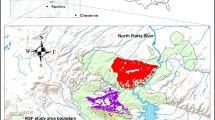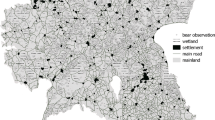Abstract
The effects of forest fires on polar bear (Ursus maritimus) maternity denning habitat in western Hudson Bay were determined by comparing the physical characteristics of 48 burned and 101 unburned maternity den sites from September 2001 to October 2003. Fire significantly altered vegetation composition and increased the depth of the active layer, resulting in a decrease in the stability of den sites, the collapse of dens, and degradation of the surrounding habitat. Although bears investigated burned areas, analysis of mark and recapture data, satellite telemetry, radio-telemetry, and field observations all demonstrated that bears did not use burned areas for denning. While peat denning habitat is likely not limiting at this time, the re-use and occupancy of peat den sites during the summer may be an important means of energy conservation for pregnant female bears in western Hudson Bay. Increased energy expenditures in association with increased search times for suitable den sites and the excavation of new dens can potentially affect reproductive success. Predicted increases in forest fire activity as a result of climate change, along with the long-term recovery of denning habitat may reduce the amount of suitable denning habitat in the future. Resource managers need to be aware of the possibility of a shift in the distribution of denning bears and further loss of maternity denning habitat in western Hudson Bay.


Similar content being viewed by others
References
Amstrup SC, Gardner C (1994) Polar bear maternity denning in the Beaufort Sea. J Wildl Manage 58:1–10
Arsenault D, Payette S (1992) A postfire shift from lichen-spruce to lichen-tundra vegetation at tree line. Ecology 73:1067–1081
Auclair AND (1983) The role of fire in lichen-dominated tundra and forest-tundra. In: Wein RW, MacLean DA (eds) The role of fire in northern circumpolar ecosystems. Wiley, New York
Bergeron Y, Flannigan M, Gauthier S, Leduc A, Lefort P (2004) Past, current and future fire frequency in the Canadian Boreal Forest: implications for sustainable forest management. Ambio 33:356–360
Black RA, Bliss LC (1980) Reproductive ecology of Picea mariana (Mill.) BSP., at tree line near Inuvik, Northwest Territories, Canada. Ecol Monogr 50:331–354
Blix AS, Lentfer JW (1979) Modes of thermal protection in polar bear cubs at birth and on emergence from the den. Am J Physiol 263:67–74
Brook RK (2001) Structure and dynamics of the vegetation in Wapusk National Park and the Cape Churchill Wildlife Management Area of Manitoba: community and landscape scales. M.N.R.M. thesis, Natural Resource Institute, The University of Manitoba, Winnipeg
Burn CR (1998) The response (1958–1997) of permafrost and near-surface ground temperatures to forest fire, Takhini River valley, southern Yukon Territory. Can J Earth Sci 35:184–199
Burrows WR, King P, Lewis PJ, Kochtubajda B, Snyder B, Turcotte V (2002) Lightning occurrence patterns over Canada and adjacent United States from lightning detection network observations. Atmos Ocean 40:59–81
Clark DA, Stirling I, Calvert W (1997) Distribution, characteristics, and use of earth dens and related excavations by polar bears on the western Hudson Bay lowlands. Arctic 50:158–166
Derocher AE, Stirling I (1990) Distribution of polar bears (Ursus maritimus) during the ice-free period in western Hudson Bay. Can J Zool 68:1395–1403
Derocher AE, Stirling I (1995) Estimation of polar bear population size and survival in western Hudson Bay. J Wildl Manage 59:215–221
Derocher AE, Stirling I, Andriashek D (1992) Pregnancy rates and serum progesterone levels of polar bears in western Hudson Bay. Can J Zool 70:561–566
Durner GM, Amstrup SC, Fischbach A (2003) Habitat characteristics of polar bear terrestrial maternal den sites in northern Alaska. Arctic 56:55–62
Eberhardt LL, Thomas JM (1991) Designing environmental field studies. Ecol Monogr 61:53–73
Englefield P, Lee BS, Fraser RH, Landry R, Hall RJ, Lynham TJ, Cihlar J, Li Z, Jin J, Ahern FJ (2004) Applying geographic information systems and remote sensing to forest fire monitoring, mapping, and modeling in Canada. In: Engstrom RT, Galley KEM, deGroot WJ (eds) Proceedings of the 22nd tall timbers fire ecology conference: fire in temperate, boreal, and montane ecosystems. Tall Timbers Research Station, Tallahassee, pp 240–245
Fernández N, Palomares F (2000) The selection of breeding dens by the endangered Iberian lynx (Lynx pardinus): implications for its conservation. Biol Conserv 94:51–61
Flannigan MD, Van Wagner CE (1991) Climate change and wildfire in Canada. Can J For Res 21:66–72
Flannigan MD, Bergeron Y, Englemark O, Wotton BM (1998) Future wildfire in circumboreal forest in relation to global warming. J Veg Sci 9:469–476
Flannigan MD, Stocks BJ, Wotton BM (2000) Climate change and forest fires. Sci Total Environ 262:221–229
Flannigan MD, Logan KA, Amiro BD, Skinner WR, Stocks BJ (2005) Future area burned in Canada. Clim Change (in press)
Gough WA, Leung A (2002) Nature and fate of Hudson Bay permafrost. Reg Environ Change 2:177–184
Hammer D (1999) Forest fires influence on yellow hedysarum habitat and its use by grizzly bears in Banff National Park, Alberta. Can J Zool 77:1513–1520
Harington CR (1968) Denning habits of the polar bear (Ursus maritimus Phipps). Canadian Wildlife Service Report Series No. 5, 30 p
Heinselman ML (1973) Fire in the virgin forests of the Boundary Waters Canoe Area. Minnesota Quat Res 3:329–382
Holcroft AC, Herrero S (1984) Grizzly bear digging sites for Hedysarum sulphurescens roots in southwestern Alberta. Can J Zool 62:2571–2575
Hurlbert SH (1984) Psuedoreplication and the design of ecological field experiments. Ecol Monogr 54:187–211
Jonkel C, Kolenosky GB, Robertson RJ, Russell R (1972) Further notes on polar bear denning habits. Int Conf Bear Res Manage 2:142–158
Koopman ME, Scrivner JH, Kato TT (1998) Patterns of den use by San Joaquin kit foxes. J Wildl Manage 51:606–616
Larsen T (1985) Polar bear denning and cub production in Svalbard, Norway. J Wildl Manage 49:320–326
Lee BS (1995) The Canadian wildland fire information system. In: Proceedings of the 9th annual symposium on geographic information systems in forestry, environment and natural resource management. GIS World, Fort Collins, pp 639–646
Lønø O (1970) The polar bear (Ursus maritimus Phipps) in the Svalbard area. Norsk Polarinstitutt Skrifter 149:1–115
Lunn NJ, Stirling I, Andriashek D, Richardson E (2004) Selection of maternity dens by female polar bears in western Hudson Bay. Polar Biol 27:350–356
Mackay JR (1995) Active layer changes (1968 to 1993) following the forest-tundra fire near Inuvik, N.W.T., Canada. Arct Alp Res 27:323–336
Manly BFJ, McDonald LL, Thomas DL (1993) Resource selection by animals: statistical design and analysis for field studies. Chapman & Hall, London
Morneau C, Payete S (1989) Post-fire lichen-spruce woodland recovery at the limit of the boreal forest in northern Québec. Can J Botany 67:2770–2782
Nagy JA, Russell RH, Pearson AM, Kingsley MCS, Larsen CB (1983) A study of grizzly bears on the Barren Grounds of Tuktoyaktuk Peninsula and Richards Island, Northwest Territories, 1974 to 1978. Canadian Wildlife Service Edmonton, Alberta
Norris DR, Theberge MT, Theberge JB (2002) Forest composition around wolf (Canis lupus) dens in eastern Algonquin Provincial Park Ontario. Can J Zool 80:866–872
Osyanikov N (1998) Den use and social interactions of polar bears during spring in a dense denning area on Herald Island, Russia. Ursus 10:251–258
Payette S, Gagnon R (1985) Late Holocene deforestation and tree regeneration in the forest-tundra of Québec. Nature 313:570–572
Pearson AM (1975) The northern Interior grizzly bear Ursus arctos L. Can Wildl Serv Rep Ser 34:86
Polischuk SC, Hobson KA, Ramsay MA (2001) Use of stable-carbon and—nitrogen isotopes to assess weaning and fasting in female polar bears and their cubs. Can J Zool 79:499–511
Price C, Rind D (1994) Possible implications of global climate change on global lightning distributions and frequencies. J Geophys Res 99:823–831
Pruitt WO (1957) Observations on the bioclimate of some taiga mammals. Arctic 10:131–138
Ramsay MA, Stirling I (1986) On the mating system of polar bears. Can J Zool 64:2142–2151
Ramsay MA, Stirling I (1988) Reproductive biology and ecology of female polar bears (Ursus maritimus). J Zool Lond 214:601–634
Ramsay MA, Stirling I (1990) Fidelity of female polar bears to winter den sites. J Mammal 71:233–236
Regehr E, Lunn NJ, Amstrup SC, Stirling I (2005) Population decline of polar bears in Western Hudson Bay in relation to climatic warming. In: 16th biennial conference on the biology of marine mammals, San Diego, California, 12-16 December 2005. Society for Marine Mammalogy, p 233 (Abstract only)
Richardson E (2004) Polar bear (Ursus maritimus) maternity den site selection and the effects of forest fires on denning habitat in western Hudson Bay. M.Sc Thesis, Department of Biological Sciences, University of Alberta, Edmonton
Richardson E, Stirling I, Hik DS (2005) Polar bear (Ursus maritimus) maternity denning habitat in western Hudson Bay: a bottom up approach to resource selection functions. Can J Zool 83:860–870
Ritchie JC (1960) The vegetation of northern Manitoba V. Establishing the major zonation. Arctic 13:211–229
Russell, RH (1983) Swift fox. In: Hinterlands Who’s Who. Canadian Wildlife Service, Environment Canada, Ottawa
Schweinsburg RE, Spencer W, Williams D (1984) Polar bear denning area at Gateshead Island, Northwest Territories. Arctic 37:169–171
Scott PA, Stirling I (2002) Chronology of terrestrial den use by polar bears in western Hudson Bay as indicated by tree growth anomalies. Arctic 55:151–166
Skinner WR, Jefferies RL, Carleton TJ, Rockwell RF, Abraham KF (1998) Prediction of reproductive success and failure in lesser snow geese based on early season climatic variables. Glob Chan Biol 4:3–16
SPSS Inc. (1998) SPSS®. Version 8.0 [computer program]. SPSSInc., Chicago
Stirling I, Spencer C, Andriashek D (1989) Immobilization of polar bears (Ursus maritimus) with Telazol® in the Canadian Arcitc. J Wildl Dis 25:159–168
Stocks BJ, Mason JA, Todd JB, Bosch EM, Wotton BM, Amiro BD, Flannigan MD, Hirsch KG, Logan KA, Martell DL, Skinner WR (2003) Large forest fires in Canada, 1959–1997. J Geophys Res 107:1–12
Suffling R, Scott D (2002) Assessment of climate change effects on Canada’s national park system. Environ Monit Assess 74:117–139
Swanson DK (1996) Susceptibility of permafrost soils to deep thaw after forest fires in interior Alaska, U.S.A., and some ecological implications. Arct Alp Res 28:217–227
Thie J (1974) Distribution and thawing of permafrost in the southern part of the discontinuous permafrost zone in Manitoba. Arctic 27:189–200
Uspenski SM, Kistchinski AA (1972) New data on the winter ecology of the polar bear (Ursus maritimus) on Wrangel Island. IUCN (Int Union Conserv Nat Nat Resour) Publ New Ser 23:181–197
Watts PD, Hansen SE (1987) Cyclic starvation as a reproductive strategy in the polar bear. Symp Zool Soc Lond 57:305–318
Wein RW, Bliss LC (1973) Change in arctic Eriophorum tussock communities following fire. Ecology 54:845–852
Weins JA, Parker KA (1995) Analyzing the effects of accidental environmental impacts: approaches and assumptions. Ecol Appl 5:1069–1083
Zoltai SC, Petapiece WW (1974) Tree distribution on perennially frozen earth hummocks. Arct Alp Res 6:403–411
Acknowledgments
We wish to thank Parks Canada, Canadian Wildlife Service, World Wildlife Fund Canada, Polar Bears International, Natural Science and Engineering Research Council (Ian Stirling), Northern Science Training Program, University of Alberta and the Churchill Northern Studies Centre for providing financial support to this project. D. Andriashek, N. Lunn, S. Sutton, K. Burke, J. Henderson all provided assistance in the field. R. Brook provided access to the Wapusk National Park vegetation map and the original satellite imagery. N. Lunn provided valuable comments on the initial manuscript. We thank Andy Derocher and one anonymous reviewer for their constructive criticism, which improved the overall quality of the manuscript.
Author information
Authors and Affiliations
Corresponding author
Rights and permissions
About this article
Cite this article
Richardson, E., Stirling, I. & Kochtubajda, B. The effects of forest fires on polar bear maternity denning habitat in western Hudson Bay. Polar Biol 30, 369–378 (2007). https://doi.org/10.1007/s00300-006-0193-7
Received:
Revised:
Accepted:
Published:
Issue Date:
DOI: https://doi.org/10.1007/s00300-006-0193-7




